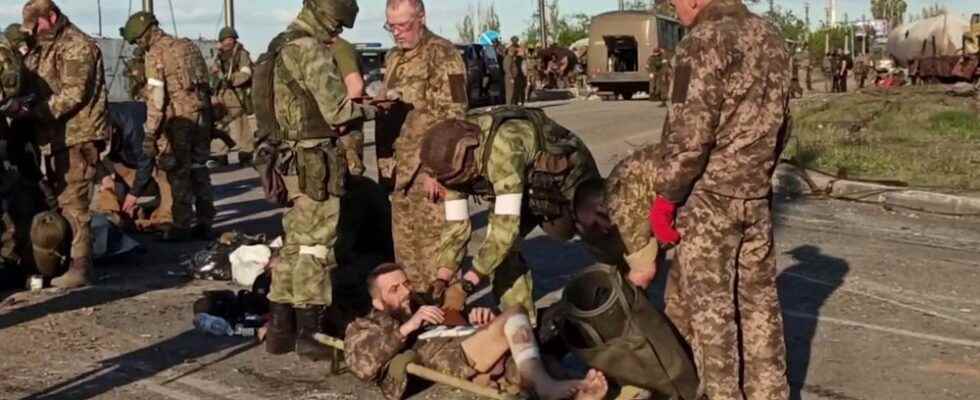At the beginning of April, to describe Mariupol, a port city of nearly 450,000 inhabitants located on the Sea of Azov, the United Nations Organization used a colorful and terrifying expression, which the photos of the last combatants entrenched in the Azovstal factory have confirmed: “it is the center of hell”. A few days later, Ukrainian President Volodymyr Zelensky declared that there was not “an undamaged building”, and deplored the presence of hundreds of Ukrainian civilians and soldiers, trapped in the immense steel complex of the city.
A month later, the civilians entrenched in the factory were brought to safety, while the evacuation of Ukrainian soldiers, some of whom are seriously injured, began on Monday. And if the latter are still in Russian hands, the Ukrainian authorities have already raised the possibility of prisoner exchanges, so that they can regain their full freedom. When there is no longer a Ukrainian fighter in Azovstal, Mariupol will have completely fallen into Russian hands. More than a month after Moscow announced its fall. And after three months of martyrdom.
A target that became a priority over the course of the war
Located 350 kilometers northeast of Crimea and about 100 kilometers south of Donetsk, Mariupol was targeted by the Russian army from the first days of the conflict. Its occupation would indeed connect Crimea, conquered in 2014, to the Donbass region, and make the Sea of Azov an inland sea for Russia. Symbolically, its capture would erase the affront of 2014, when Mariupol had resisted the desire for Russian conquests. In addition, the city is one of the strongholds of the Azov regiment, a Ukrainian nationalist military group accused by Moscow of being a neo-Nazi hideout. So many reasons, therefore, to conquer Mariupol, which will only become Vladimir Putin’s top priority because of the bad turn of the war.
Ukrainian fighters searched by pro-Russian forces after their surrender at the exit from the Azovstal industrial complex in Mariupol (video capture released by the Russian government on May 17, 2022)
afp.com/Handout
The city was bombed from the first day of the invasion, February 24, but this was the case for most of the country’s major urban centers, such as kyiv, Donetsk and Kharkiv. Moscow is betting on a blitzkrieg and spread out war, with the desire to decapitate the head of the government and terrorize the population to impose its conditions. But Ukraine resists, and Russia, bogged down on several fronts, must rethink its general strategy. She announced at the end of March that she wanted to focus on the Donbass. Already deprived of water and electricity since March 2, the inhabitants of Mariupol will now be pounded relentlessly. To show its intransigence and incite Ukraine to cease its resistance, Russia systematically frustrates, according to local authorities, the establishment of humanitarian corridors supposed to evacuate civilians.
A city symbol of war crimes
Among the dates of this war that history will remember, there is certainly March 9, the day when the Russian army, far from any military consideration, bombed the Mariupol maternity hospital and its pediatric hospital. A strike decided when a ceasefire allowing the evacuation of civilians had been agreed. The destruction of the city’s theater on March 16, when hundreds of people were sheltering there, also shocked the international community.
After two weeks of bombing, a first evacuation was made possible and 300 inhabitants were able to flee. Humanitarian corridors are becoming more frequent over time, even if Ukraine accuses Russia of blocking certain convoys. At the beginning of April, the town hall of Mariupol put the number of dead civilians at more than 2,500, in a city that was 90% destroyed. The approximately 350,000 people still present live underground, in deplorable conditions, of which the underground areas of the Azovstal steelworks will become symbols.
Azovstal, the pocket of resistance of an entire people
Russia progresses every day a little more in the conquest of the city center, and on April 10, it cuts the Ukrainian army in two, between the port and the Azovstal steel complex, a real city of steel and concrete, soon to be a bunker of survival. If the first pocket, concentrated in the port, must surrender to the Russian forces, the second takes advantage of the extent of Azovstal, the largest factory in Ukraine with its 20 kilometers of corridors dug 30 meters deep, to s ‘arrange. Impossible to bomb or conquer, it became the bunker of the resistance, the bruised image of a city set up as a nation. The war in Mariupol, 99% destroyed in early May, freezes, and all eyes turn to the trapped soldiers, whom Volodymyr Zelensky will now call “heroes”.
If the defense of Azovstal is presented, by the adviser to the Ukrainian president, as the “number one priority”, this is proving extremely difficult. While all civilians are allowed to flee, the soldiers remain. Russia grew impatient and carried out more than thirty airstrikes on the factory, before the Ukrainian soldiers agreed to leave. Since Monday May 16, “959 fighters, including 80 wounded, have become prisoners,” the Russian Ministry of Defense said in a statement on Wednesday. Now inevitable, the total capture of Mariupol will be erected as a great victory by the Kremlin, but it will not necessarily be a defeat for Ukraine.
